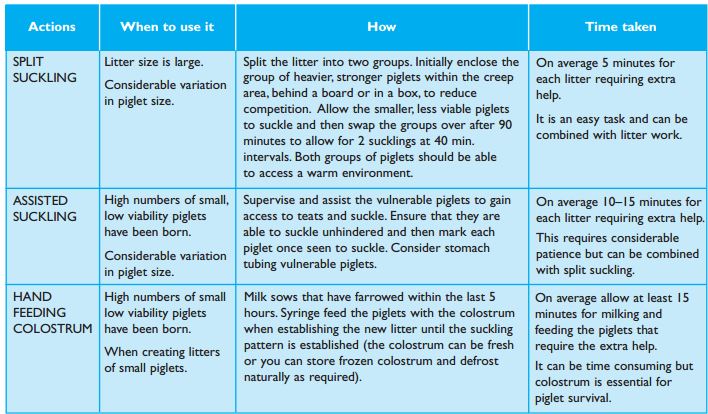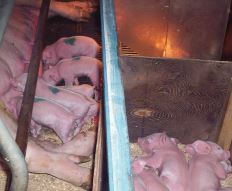



Tips for Managing Newborn Piglets
The first few hours of a piglet's life are critical for its survival. This feature gives some tips for ensuring newborn piglet health, aiming at reducing early piglet mortality and increasing weaning weights.Why are newborn piglets so vulnerable?
Newborn piglets are poorly equipped to keep warm immediately after birth and as the energy reserves to produce body heat (glycogen stored in the liver) are limited, the combination of factors below means that piglets often become chilled. Reasons for piglet chilling include:
- Small size means they lose heat fast
- Lack of brown fat (no internal heat source)
- Little surface fat and no hair (no insulation)
- Born wet with birth fluids (further chilling)
Piglets are also born with no immunity and can only get this from colostrum soon after birth. A minimum of 100 ml of colostrum per kilogram of birthweight within the first 16 hours is crucial to provide the energy, nutrients and antibodies needed for survival.
How can you help the newborn piglet and ensure a good start in life?
Monitor farrowing
Being present at farrowing is a critical part of good farrowing house management. If not possible on your unit, ask yourself why not?
Consider altering routines or rotas to provide cover at this crucial time or discuss with your vet the practicalities of using products to promote farrowing during the daytime, when you can be present.
Colostrum
- Colostrum is the ‘first milk’ and an essential source of energy, nutrients and immunity for the piglet
- Colostrum is critical for development of the piglets’ own immune system and optimum lifetime performance.
- Maximise colostrum intake in the first 6 hours after birth achieving at least 100 ml intake per kilogram of birthweight by 16 hours post farrowing.For example, a 1.45 kg piglet would need a minimum of 145 ml colostrum.
- Beyond 24 hours is too late as the piglets’ intestines can no longer absorb the large antibodies found in colostrum.
- Colostrum is only available in quantity for about 12 hours and after 20 hours the sow will be producing milk and not colostrum

Fostering Management
Cross fostering: Make sure all staff are aware of your farm fostering policy. Sometimes practices change for the better but can revert back if your cover staff are not aware of the changes. Wherever possible leave piglets with their own mothers to avoid disruption of the litter suckling patterns; even big piglets looking secure and strong will experience growth checks if fostered, especially if moved around frequently.
Even up numbers of piglets per litter: Matching the number of piglets to the number of functioning teats allows each piglet to have easy access to the colostrum produced after farrowing. This improves piglet survival rates and increases the chance of piglets achieving their potential growth rates.
Helping low birthweight piglets: It is a great disadvantage for small piglets to have to compete with larger littermates. Litters of small piglets should be created from all the ‘smalls’ born in a given farrowing day. Foster-litters of small piglets should be put with low-parity sows; the teat size of a low-parity sow will match the small mouths of the small piglets.
Piglet sex: In general it is the female pigs within a contemporary group which are best able to cope with management changes. Consider fostering female piglets rather than males when possible.
Following a few basic rules for fostering will help ensure piglet health:
- Foster within the first 24 hours
- Ensure foster piglets get early colostrum, preferably from their own mother, or if not then from a very recently farrowed foster mother
- Give the smaller piglets warm colostrum (sow, artificial or pasteurised bovine) or glucose
- Foster only once, it can be detrimental to keep moving litters around
- Never have more piglets than functioning teats on sows
- Remember, small piglets find suckling from large teats difficult
- Foster within a room (batch of piglets) wherever possible, don’t move health problems to other groups
It is important to keep a close eye on the piglets to ensure their health. Be on the look out for fading piglets and take remedial action by fostering and providing electrolytes or additional milk.
Check for signs of ill health and treat according to the unit's veterinary protocol. Ensure piglets are lying either on or under the heat source and not piling together, as this indicates chilling.
Creep training
Piglets have different thermal requirements to sows, and the creep area provides the required environment for the piglets, so training them to use this area will provide them with a good start in life.
The creep has a secondary advantage of being a safe area where piglets can lie away from the sow and the risk of being laid on.
Piglets learn the behaviour of using creeps within the first 40–48 hours of life.
Enclose the piglets within a closed creep ie ‘train the piglets’ as soon as they have finished suckling. This can be combined with split suckling, saving time by carrying out the two activities at the same time. Keep piglets in the creep area for approximately 1 hour.
June 2015









